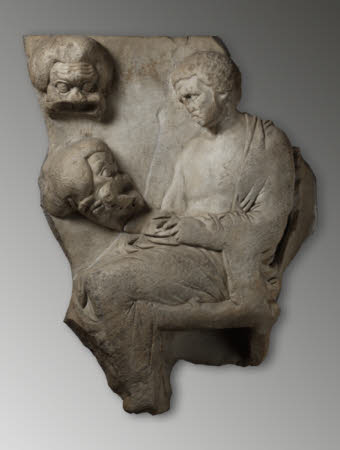Stele of a comic poet
Category
Art / Sculpture
Date
380 BC - 350 BC
Materials
Marble
Measurements
1140 x 860 mm
Place of origin
Athens
Order this imageCollection
Lyme, Cheshire
NT 500255.1
Caption
This rare and extraordinary tomb carving celebrates the life of a Greek comic poet who died some 300 years before the birth of Christ. He carries an actor’s mask and holds a scroll, which suggests he is a poet or performer. Although we don’t know his name, he must have been widely celebrated to merit a gravestone commemorating his skills. This was not only the age of Socrates, Plato and Aristotle but also a time of regular conflict between Athens and its neighbouring city states. The poet’s life may have been full of laughter and creativity, but he would almost certainly have served demanding and well-educated masters. The grave relief was found outside Athens around 1812–13 and brought back to England by the explorer Thomas Legh (?1793–1857), who installed it (along with two others) in the remodelled library of his house at Lyme, Cheshire. It remains in situ today as a poignant reminder of both the power and importance of laughter and the connections between a lost civilisation and our own.
Summary
Marble sculpture of the fourth century BC, from Athens, depicting a seated, bearded, male holding a scroll and gazing at a comic mask while a second mask hangs above him.
Full description
Marble sculpture of the fourth century BC, from Athens. Carved in high relief with the image of a bearded male actor, seated in profile and wearing draped himation; holding a bearded male comic mask in his right hand, with a second mask suspended above. The individual depicted may be a comic poet, or perhaps a character from a comic play. It is unclear whether the sculpture formed part of a funerary monument or a dedication. This well-preserved grave relief is one of three pieces of Athenian sculpture displayed at Lyme Park in Cheshire. They were excavated by Thomas Legh (?1793-1857), who inherited the Lyme estate in 1797. Legh travelled through Greece, Turkey, Egypt and Sudan between 1812 and 1817 and was involved in excavating, collecting and financing the export of a small number of significant artefacts. In this relief, a bearded male figure sits holding an actor’s mask in his right hand and clasps a scroll in his left. Another mask hangs on a wall behind him. It has been suggested the masks represent a young slave and an old man, two popular characters of the Athenian theatrical genre of the 4th century B.C. known as the Middle Comedy. The seated figure, whose beard has been reworked, has a troubled expression and is perhaps seeking inspiration. The grave relief was produced in an Athenian workshop and probably commemorates a Middle Comedy writer or poet, but there is no inscription and his identity is unknown. It was excavated by Legh between 1812 and 1813, probably in the area of the Keramaikos cemetery outside of the Dipylon Gate, Athens. He brought it back to Lyme with two other grave reliefs and these were installed in the remodelled library by his architect Lewis Wyatt.
Provenance
Collected by Thomas Legh (1792-1857, who inherited the Lyme estate in 1797), in 1811 or 1821, probably in Athens, possibly in area of the Kerameikos cemetery. This object, along with two funerary stelai, were installed in Lyme Hall’s remodelled Library for Thomas Legh by the architect Lewis Wyatt.
Marks and inscriptions
MARBLE BASSO RELIEVO, / found in a sepulchure at Athens, / April 1812 (engraved on a brass plaque fixed to the wall)
References
Legh, Thomas, 1793-1857 Narrative of a journey in Egypt and the country beyond the cataracts. / 1817. Strong, Eugénie, 1860-1943 Three sculptured stelai : in the possession of Lord Newton at Lyme Park / [1903], pp. 356-9 Liddel and Low 2019: Peter Liddel and Polly Low, Attic Inscriptions in UK Collections. Volume 5. Lyme Park (2019). Online publication: https://www.atticinscriptions.com/papers/aiuk/-5/ Scholl 1995: A. Scholl, ‘Nicht Aristophanes, Sondern Epigenes: das Lyme-Park-Relief und die Darstellung von Dichtern und Schauspielern auf Attischen Grabdenkmälern’, Jahrbuch des Deutschen Archäologischen Instituts (Athen) 110, 213-38

